Dual over/under configurations extend lower frequencies and help image through basalt and salt, as well as improve steep dip imaging. Triple over/under acquisition further improves data quality, especially in rough sea conditions.
Ralf Ferber, WesternGeco, UK
Conventional towed-streamer marine seismic acquisition systems deploy sources and streamers at shallow depths, typically between 6 and 10 m. This configuration enables recording of the high frequencies needed for resolution, but attenuates the low frequencies needed for stratigraphic and structural inversion. Shallow towing also makes the data more susceptible to environmental noise, such as waves, swell and wind.
Towing sources and streamers at greater depths enhances the low-frequency content and can increase the signal-to-ambient-noise ratio (S/N); however, it attenuates the high frequencies. The attenuation is due to interference of the upgoing seismic wavefield with its ghost, as recorded by the pressure sensors in the streamers. (A ghost is the reflection of the wavefield after bouncing back from the sea surface above the streamer.) As the streamer depth increases, the delay between the upgoing seismic wavefield and its downgoing ghost increases, while the attenuated notch in the amplitude spectrum moves toward lower frequencies.
THE DUAL OVER/UNDER SEISMIC TECHNIQUE
Designing tow depths for conventional towed-streamer surveys, therefore, requires a compromise to optimize bandwidth and S/N for a specific target depth or two-way traveltime. This is often at the expense of other shallower or deeper objectives. Data recorded by over/under dual towed streamers can avoid this compromise, delivering the high-frequency characteristics of conventional shallow-towed configurations and, at the same time, providing the low-frequency characteristics of deep-towed data. In addition, a deep-towed over/under configuration can improve S/N.
The dual over/under technique involves two streamers, one towed vertically above the other, both typically significantly deeper than would be used for a conventional towed-streamer configuration (e.g., at 20 and 30 m). There may be one or two sources (or source arrays), each with a source ghost(s) as shown in Fig. 1. What holds for the streamer side also holds for hte source side. Data from the two streamers are combined in data processing into a single dataset, where the streamer ghost has been removed. This process is commonly referred to as deghosting.
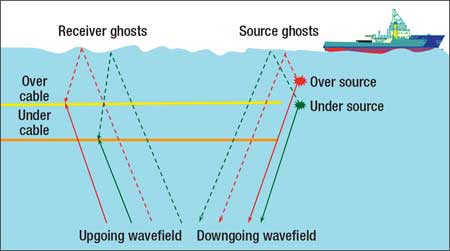 |
|
Fig. 1. Dual-source, dual-streamer over/under configuration.
|
|
The over/under method was tested during the 1980s with some encouraging results. However, data quality was unreliable, primarily because it was impossible to keep the two streamers vertically paired. Ocean current strength and direction often vary considerably as a function of both time and depth. This can cause a lateral displacement of several hundred meters between the far offsets of two conventional 6,000-m streamers, towed at different depths. The Fresnel zone concept can be used to determine the acceptable lateral tolerance between the two over/under streamers. Using a typical marine depth-velocity-decay function, this concept indicates that for a target at 2.5-s two-way time, midpoints should be within 5 m. This is equivalent to 10-m lateral displacement between receivers in the upper and lower streamers. Considering the need for such accuracy, it is no surprise that the early over/under tests proved so variable.
Steerable streamers enabled the accuracy needed to achieve the benefits of the over/under method. Streamers can be steered with the required horizontal alignment and accurate depth control. In addition to managing lateral displacement, the small sensor interval of the system also enables minimization of the effect of inline displacement between sensors in the two streamers.
Since 2001, the dual over/under technique has been demonstrated in several 2D and 3D projects to increase low-frequency content, providing deeper penetration and, therefore, improved imaging beneath highly absorptive overburdens such as basalt and salt. Extension of lower frequencies also improves steep dip imaging and makes seismic inversion less dependent on model-based methods. Further improvement has been achieved by deploying over/under sources, enabling removal of both the cable ghost and source ghost.
OVER/UNDER DEGHOSTING TECHNIQUES
Amplitude spectra for a dual streamer setup is shown in Fig 2a and 2b. One of two types of algorithm, “dephase and sum,” or “shift and subtract,” is used for the dual over/under deghosting process. Dephase and sum is shown in Fig. 2. These algorithms are mutually exclusive and have their specific strengths and weaknesses. This “twin-streamer processing dilemma” is shown schematically in Fig. 3.
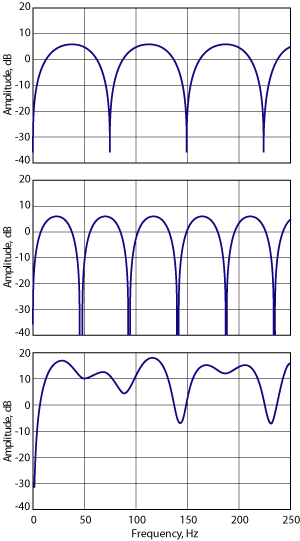 |
|
Fig. 2. a) and b) Twin streamer over (10 m) /under (16 m) amplitude spectra. c) Twin streamer amplitude spectrum after dephase and sum algorithm.
|
|
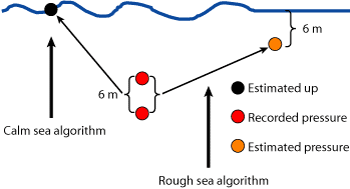 |
|
Fig. 3. The twin-streamer processing dilemma: Choose whether to estimate the upgoing wavefield at the sea surface while preserving the rough-sea surface perturbations, or estimate calm sea surface pressure recordings while introducing a pseudo-calm-sea surface ghost.
|
|
Dephase-and-sum algorithms correlate each seismic trace with a surface ghost operator to zero-phase the ghost operator. After de-phasing and temporal alignment of the dephased data, corresponding traces from each streamer are summed to produce a single trace. Because the sum of the power spectra of the individual ghost wavelets is not flat, a further zero-phase inverse filter is applied.1,2
This algorithm has the advantage that the summed traces after dephasing have an amplitude transfer function for upgoing waves that equals the sum of the power spectra of the individual surface ghosts. For this reason, the algorithm fills the notches in the amplitude spectrum in the best possible way. The drawback is that, for the de-phasing step, the method requires explicit knowledge of the surface ghost, which is usually very difficult to get. Modeling of the ghost assumes reflection coefficients based on a calm seasurface. This calm sea algorithm fails in rough sea conditions and introduces a perturbation to the output.
Shift-and-subtract algorithms time shift the data from one of the streamers to align the downgoing waves with those data from the other streamer. Subtraction of one dataset from the other effectively removes the ghost energy. The required time shift is a function of the dip of the incident wave and the vertical streamer separation. The actual depth of the individual streamers is not required. Such shift-and-subtract techniques1,3,4 remove the downgoing wave from twin-streamer data, and hence, the free-surface effect, with the advantage that this effect does not need to be explicitly known.
Shift-and-subtract algorithms can be interpreted as simulating the dataset that would result from a single streamer towed in perfectly calm weather at a water depth equal to the separation between the two streamers. The drawback is that the subtraction process leaves a pseudo-calm-sea surface ghost in the data at the two-way traveltime between the two streamers. The pseudo-ghost cannot be removed perfectly from the combined over/under data due to its spectral notches. The pseudo-ghost can be dephased, as it is perfectly known, and a zero-phase inverse filter can narrow the individual notches, but never fill them in fully.
ADVANTAGES OF A THIRD STREAMER
The shift-and-subtract algorithm compensates for rough sea conditions and simulates a dataset from calm sea conditions from the dual streamer data. It is very unfortunate that the dephase-and-sum algorithm cannot be applied to this simulation, because that would give a best-of-both-worlds result. If data from an additional streamer were available, the two classes of algorithms could be combined, enabling the particular benefits of both classes to be realized.
A triple-streamer over/under data acquisition configuration would provide three subsets of two over/under streamers, each of which could input to the shift-and-subtract algorithm to remove the downgoing waves with their actual rough sea surface perturbations, thus simulating a calm sea, triple-streamer over/under dataset. The dephase-and-sum algorithm could then be applied to the simulated calm sea datasets, dephasing each simulated single streamer dataset using the corresponding calm sea ghost operator, before spectrally weighted summation, to estimate the upgoing wavefield at a sea level datum. This proposed algorithm to process data from more than two over/under streamers is shown schematically in Fig. 4 for the case of three streamers.
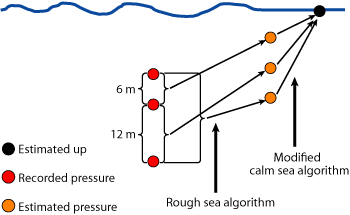 |
|
Fig. 4. The advantage of having three streamers: Three pressure recordings in calm sea are first simulated from the three actual pressure recordings under actual sea conditions. These estimated recordings are then combined into an estimate of the upgoing wave at the sea-surface.
|
|
The proposed algorithm deals with multiple-streamer over/under configurations in its most general form, i.e., for an arbitrary number of streamers. A generalized multi-streamer vertical over/under processing flow is depicted as a flow chart in Fig. 5. The main application will most probably be for a triple-streamer configuration. Twin-streamer processing aimed at attenuating the rough sea surface perturbations, as mentioned above, typically requires an algorithm based on a shift-and-subtract algorithm. This leads to an additional requirement that the vertical separation of the streamers be small-typically less than 6 m, to push the higher-frequency notches of the remaining calm sea surface pseudo-ghost out of the seismic frequency band. With the proposed multiple-streamer algorithm, this requirement can be relaxed, such that the streamers can have a larger and more suitable vertical separation.
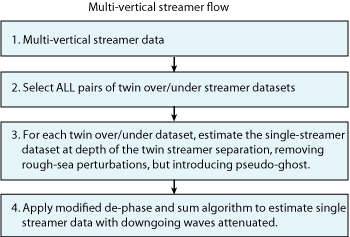 |
|
Fig. 5. Generalized multi-streamer vertical over/under processing flow.
|
|
The streamer separation should not be constant, nor a multiple of a common separation interval, to avoid the sharing of notch frequencies by individual pseudo-ghosts. Another advantage of the proposed multiple-streamer configuration is that signal-to-noise ratio, especially at low frequencies, can be much improved over that of the twin-streamer configuration. Figure 6 shows the results of triple streamer acquisition after processing through normalization.
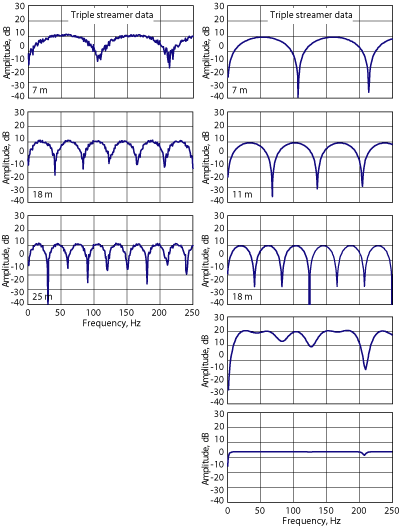 |
|
Fig. 6. a) through c), left. Triple streamer amplitude spectra at 7, 18 and 25 m, respectively. a) through c), right. Estimated data after shift and subtract. d) Result after dephasing and summation. e) Final result after normalization.
|
|
CONCLUSIONS
Multiple-streamer over/under data can provide several twin-streamer datasets. The data of each twin-streamer subset can be used to simulate the data of a single streamer in totally calm sea conditions, independent of the actual sea conditions. The number of simulated streamers can be far larger than the number of streamers in the actual configuration. If more than two streamers are used, no compromise is required between the wish to attenuate sea-surface perturbations and sea-surface ghosts, as with the twin-streamer configuration. 
ACKNOWLEDGEMENT
The author thanks Leendert Combee, Ed Kragh, Robert Laws and Johan Robertsson of Schlumberger for many fruitful discussions.
LITERATURE CITED
1 Monk, D. J., “Wavefield separation of twin streamer data,” First Break, 8, 1990, pp. 96-104.
2 Posthumus, B. J., “Deghosting using a twin streamer configuration,” Geophysical Prospecting, Vol. 41, 1993, pp. 267-286.
3 Sonneland, L. and L. E. Berg, “A new method for separating wavefields into up-and down-going components,” 47th Meeting European Association of Geoscientists and Engineers, Extended Abstract, 1985.
4 Amundsen, L., “Wavenumber-based filtering of marine point-source data.” Geophysics, 58, 1993, pp. 1335-1348..
|
THE AUTHOR
|
| |
Ralf Ferber is the Research and EMS Chief Geophysicist at the WesternGeco London Technology Center. He joined Prakla-Seismos in 1986 and has been involved in geophysical projects all over the world. Ralf previously served as a Geophysical Advisor at WesternGeco, Gatwick, and Program Manager for Acquisition & Processing and Borehole Seismics at Schlumberger Cambridge Research Center. He holds an MS in mathematics and a PhD in geophysics, both earned at Ruhr-Universität Bochum in Germany.
|
|
|








